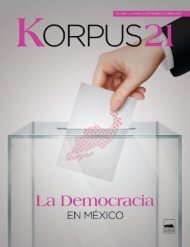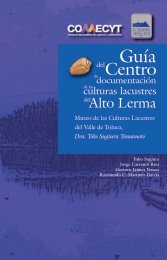You also want an ePaper? Increase the reach of your titles
YUMPU automatically turns print PDFs into web optimized ePapers that Google loves.
KORPUS <strong>21</strong>, VOL. 4, NÚM. <strong>10</strong>, 2024, 113-126<br />
he recalled. Now she was in pants, her hair long,<br />
without stockings or a bra. She and her team of<br />
students, bonded by a commitment to art, egalitarian<br />
politics, and unity, had salvaged wrecked<br />
cars from all over the city, discarding all but the<br />
twisted, rusted, burned-out frames in which the<br />
play’s characters lived. The cars were obviously<br />
a critique of consumerism, the wreckage and exclusion<br />
it wrought. Felida’s changing lighting illuminated<br />
the different stories of these marginal<br />
people, “vagabonds of the street living in the<br />
poverty zones” recalled Pepe.<br />
The couple in one car were making love. In another,<br />
a woman gave birth to a baby of unknown<br />
paternity. In a third, lived an army officer with a<br />
lesbian and, in another, a conventional couple.<br />
The story developed as an allegory of the Crucifixion<br />
set to the music of the Beatles. The main<br />
actors were three hippie youths: Emanu as Jesus<br />
and his two friends, representing apostles Peter<br />
and Judas.<br />
They came to play music to rescue the poor<br />
from their misery. With them was Dila, Mary<br />
Magdalene, whose gigolo lover had forced her<br />
into prostitution. His violence she transformed<br />
into tenderness in her relationship with the boys.<br />
She protected Emanu, a mute, effeminate lad<br />
who knit sweaters to protect beggars from the<br />
cold but whose trumpet symbolized for one critic<br />
a rifle of revolution. Sensing Emanu’s threat to<br />
the social edifice, the authorities announced an<br />
award for his capture.<br />
His closest friend, Judas, betrayed him and<br />
turned him over to secret police agents, the<br />
same couple who had made love in their car.<br />
The crucifixion took place virtually: the police<br />
beat the ground rather than Emanu. Dila marked<br />
in red pencil the slashes on his back. The police<br />
tied him to a car and crucified him on a bicycle.<br />
As the audience heard a little doll repeat as she<br />
had throughout the play, “I love you very much,<br />
tell me a story”, the figure of Emanu was projected<br />
in film onto a sheet as he escaped over<br />
a viaduct into meadows of flowers. Suddenly<br />
the technicolor of the flowers turned to damaged,<br />
blurred, black and white film as Emanu ran<br />
frantically to a place where he came upon the<br />
wounded body of Che Guevara. The play ended<br />
as the boy, smiling and making a victory gesture<br />
with his hand, waved goodbye to the dying<br />
guerrillero.<br />
Pepe was carried away. “It was very sad, very<br />
moving —to see the way the young actors expressed<br />
their emotions. I cried but I also felt a<br />
love for life. I was excited. It made me think. It<br />
made me question myself. Not only the actors<br />
but the effects— the lights, the film’s projection<br />
on the sheet, the Beatles music. The shells of the<br />
wrecked cars were unique sculptures, works of<br />
art. It was a repudiation of the authorities, a rebellion.<br />
It was about our poor, those with little<br />
education but the will to overcome. We are neither<br />
good nor bad, it’s the circumstances that<br />
turn us bad and thwart us. One lives saturated<br />
and surrounded by this ambience, part of it is<br />
about loving and being loved, and another part<br />
is revolting and disgusting. The poor cannot get<br />
out because they are censored and kept down.<br />
There was more and more rancor and rebellion<br />
in youth, and I identified with them”.<br />
Subsequently in the biography, I followed<br />
Pepe through La Esmeralda and his early exhibits<br />
to his departure for Paris on a government<br />
fellowship to study painting at the Ecole des<br />
Arts Décoratifs. Then I wrote an epilogue about<br />
his painting and that of his generation emphasizing<br />
the diversity and freedom of styles and<br />
subject matter. I looked at the men’s exploration<br />
of emotions but noted surprisingly few plastic<br />
inquiries into the body —that concern would<br />
be taken up for the next generation. When the<br />
Spanish language book came out, I saw him<br />
less and less and missed the excitement of our<br />
shared learning experience. When we were into<br />
that, I would ask him, “Were you listening to<br />
the Modern Jazz Quartet around 1965”. “Yes, of<br />
course,” he would answer and ask, “Along with<br />
Miles Davis’ Sketches of Spain”. I listened and<br />
melted upon hearing that trumpet echo across<br />
the barren Moorish plain. We had seen together<br />
Pasolini’s Gospel according to St. Matthew. Now,<br />
he said, “We had to see his Teorema”. We did.<br />
I do not believe that as a biographer I became<br />
over-enamoured of Pepe. That Pepe is a committed<br />
gay man gave our relationship a certain<br />
kind of distance that also reduced other kinds<br />
of distances —particularly of our shared tastes,<br />
our deep friendship. I mention his homosexuality<br />
at the end of this essay because I am afraid<br />
that had I introduced it immediately, this essay<br />
would be read in search of a gay experience.<br />
Pepe was perfectly up front about his relation-<br />
123


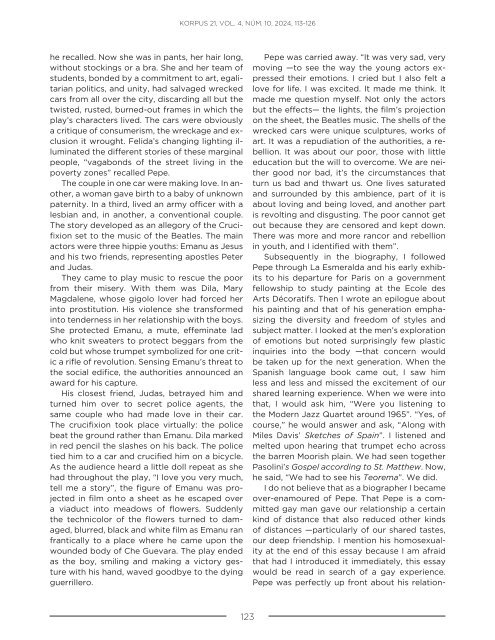
![bicentenario_1[V2]](https://img.yumpu.com/68677971/1/167x260/bicentenario-1v2.jpg?quality=85)





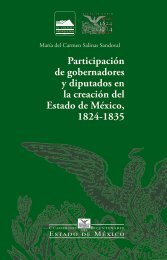


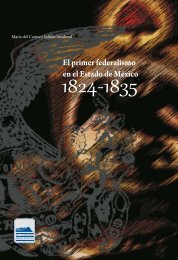
![El_primer_federalismoEM[final]_compressed (2)](https://img.yumpu.com/68483279/1/178x260/el-primer-federalismoemfinal-compressed-2.jpg?quality=85)
